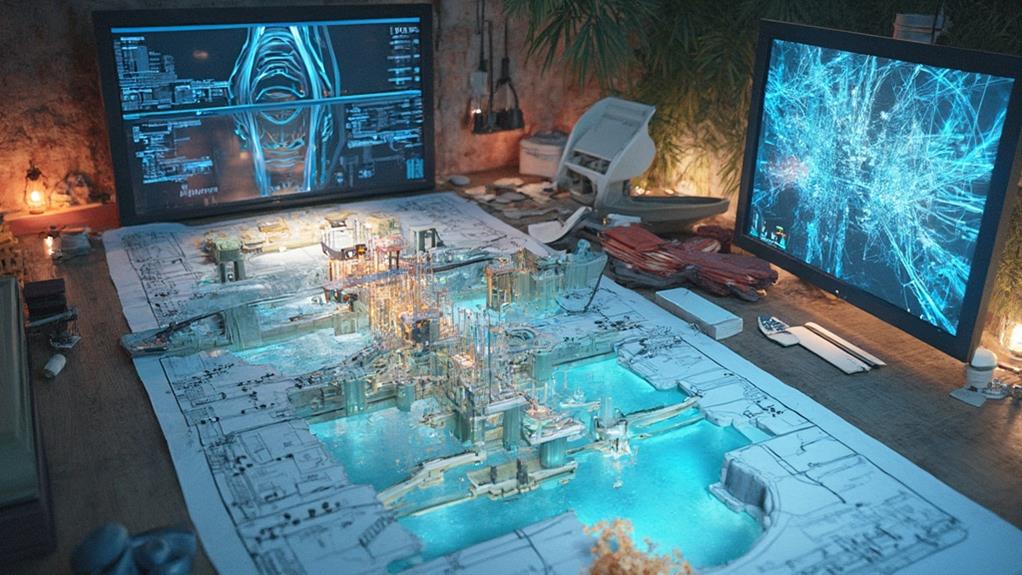In the landscape of retaining wall design, leading software solutions such as those with robust 3D modeling capabilities and real-time collaboration features are highly valued by professionals. These tools integrate intuitive interfaces with advanced geotechnical calculations and customizable material libraries, ensuring precise design and computational accuracy. Pricing models are varied, offering subscription and perpetual licensing options, with many solutions providing free trials. The intuitive navigation and thorough support documentation enhance user experience and functionality. Reviews highlight the importance of these tools in optimizing material usage and streamlining workflow processes, making them indispensable for efficient project delivery and adherence to industry standards.
Table of Contents
ToggleWalls Contractor Highlights
- Look for software featuring 3D modeling and real-time collaboration to enhance design visualization and teamwork efficiency.
- Opt for solutions with advanced geotechnical calculations and customizable material libraries for precise and tailored design accuracy.
- Choose software with intuitive interfaces and robust functionality praised in user reviews, ensuring ease of use and comprehensive design capabilities.
- Find options that offer subscription-based or perpetual licensing to match organizational budgets and long-term financial strategies.
- Consider platforms with cloud-based project sharing and seamless integration with tools like AutoCAD for enhanced collaboration and efficiency.
Top Retaining Wall Software

In exploring top retaining wall design software, it is essential to focus on innovative features that set each application apart, ranging from advanced structural analysis capabilities to integrated 3D modeling systems that enhance precision and visualization. While these tools are indispensable for designing various wall types, they are particularly valuable when planning boulder walls, which require careful consideration of size, shape, and placement for ideal stability.
An examination of user-friendly interfaces is equally crucial, as the efficiency and accessibility of a software can greatly impact a designer's workflow and learning curve. Additionally, a broad review of cost and licensing options will provide valuable insight into the investment required, ensuring that software selections align with both budgetary constraints and project demands.
Innovative Features Highlights
Technology continues to revolutionize the construction industry, particularly in designing efficient and durable retaining walls. Modern software solutions introduce innovative features that enhance not only the precision of designs but also streamline the workflow for engineers and architects. These advanced tools foster a sense of belonging within the engineering community, guaranteeing professionals that their work is supported by cutting-edge technology.
3D Modeling and Visualization: This feature allows engineers to create and view detailed three-dimensional models of retaining walls, helping them anticipate and resolve design challenges before construction begins. By visualizing the end result, teams are more connected and clear on the goals.
Real-Time Collaboration: Enhancing teamwork, this functionality enables multiple users to work simultaneously on the same project, reflecting updates instantly. This keeps everyone aligned and fosters a shared sense of purpose and progress.
Advanced Geotechnical Calculations: Accurate soil and slope stability assessments guarantee the highest standards of safety and reliability in wall design, providing peace of mind through thorough risk evaluations.
Customizable Material Libraries: By offering a vast array of construction materials and specifications, this feature allows for tailored projects that meet specific engineering requirements, reinforcing a connection with material choices that correspond to unique project needs.
User-Friendly Interface Analysis
Amidst the plethora of modern design tools, a user-friendly interface stands as a critical feature for top retaining wall software, guaranteeing that both novice and experienced engineers can navigate the system with ease. Such interfaces are designed to create an inclusive environment where users feel confident in their ability to access core functionalities without unnecessary complications. Top software platforms integrate intuitive navigation, logical layout of tools, and responsive feedback mechanisms—all contributing to a seamless interaction.
An exemplary user-friendly interface does not compromise on the depth of features, rather it strategically organizes complex functions through streamlined menus and customizable toolbars. This allows engineers to tailor the workspace according to their preferences, promoting efficiency and fostering a sense of ownership over the design process. Drag-and-drop capabilities, real-time visualization, and straightforward data entry processes further enhance user engagement by minimizing manual input complexities.
Moreover, thorough tutorial support, integrated help documentation, and interactive guides are integral components that guarantee users of varying proficiency levels are supported at each step. By facilitating learning through these resources, the software creates a cohesive community, empowering users to master sophisticated design nuances while nurturing their professional growth.
Cost and Licensing Options
When selecting the best retaining wall design software, cost and licensing options play a pivotal role in the decision-making process, as organizations and individual users must consider their budgetary constraints alongside their functional needs. The vast array of software solutions available today offers varying pricing structures and licensing terms, influencing both short-term affordability and long-term value. For those seeking a sense of belonging within professional circles, understanding these aspects is essential to guaranteeing both financial viability and alignment with industry norms.
Many top software options provide subscription-based pricing, allowing users to opt for monthly, annual, or multi-year plans. This flexibility ensures that the cost aligns with both individual project timelines and organizational growth strategies.
Some software offers perpetual licensing, providing lifetime access with a one-time fee. This can be advantageous for firms looking to minimize recurring costs, presenting an appealing option for stable, long-term use.
Depending on complexity and feature inclusion, tiered pricing models cater to diverse project scales, offering a means to pay only for needed functionality.
To foster informed decision-making, many vendors offer free trials or demo versions, enabling users to evaluate software capabilities without initial financial commitment.
Benefits

Utilizing the best retaining wall design software presents considerable advantages, chiefly in enhancing project efficiency and implementing cost-effective solutions. These advanced tools improve design accuracy dramatically, ensuring that engineers can create precise, robust structures tailored to specific site requirements.
Specialized equipment and experienced professionals can further enhance the efficiency and quality of retaining wall projects. Additionally, they facilitate streamlined workflow processes, thereby optimizing the allocation of time and resources throughout the project lifecycle.
Enhanced Project Efficiency
A well-designed retaining wall can profoundly enhance project efficiency, addressing critical aspects such as time management, cost reduction, and structural integrity. Utilizing cutting-edge retaining wall design software facilitates seamless project execution, harmonizing team collaboration and maximizing productivity. This technological advancement guarantees that engineers, architects, and construction professionals can efficiently navigate complex designs, reduce errors, and stay aligned throughout the entire project lifecycle.
The following key elements contribute to enhanced project efficiency:
- Streamlined Workflow: Automated calculations and modeling features decrease manual labor, allowing team members to allocate their time toward more critical tasks. This not only accelerates project timelines but also fosters a smooth, uninterrupted progression from conceptualization to completion.
- Improved Accuracy: Digital simulations and analysis tools provide precision in predicting wall behavior under various conditions, minimizing the risk of structural failure and reinforcing project safety.
- Collaborative Environment: Advanced software solutions offer real-time sharing and modification capabilities. Teams can work cohesively, fostering a sense of unity and belonging that enhances project coordination.
- Customization and Adaptability: Design tools permit tailoring for specific site conditions and client needs, empowering professionals to deliver personalized solutions that resonate with stakeholders, fostering trust and satisfaction.
In adopting these innovative technologies, the community of professionals drives project success and demonstrates a commitment to excellence.
Cost-Effective Solutions Implementation
Implementing cost-effective solutions in retaining wall design can markedly enhance project viability and sustainability. Cost efficiency is not merely a financial consideration but a method to guarantee the responsible allocation of resources and the achievement of long-term benefits.
By utilizing specialized retaining wall design software, professionals can access advanced algorithms and tools that optimize material usage and reduce waste. For instance, the software precisely calculates the minimal materials required, aligning construction practices with both economic and environmental goals.
Moreover, implementing cost-effective design solutions facilitates improved project timelines. With software tools enabling rapid prototyping and simulations, design modifications become swift and straightforward, allowing teams to identify potential issues before they escalate into costly disruptions.
Additionally, efficient communication channels integrated within these platforms foster collaboration among stakeholders. This interconnectedness confirms that clients, engineers, and contractors are aligned on design specifications and budget limitations, ultimately fostering a harmonious and inclusive project environment.
Improved Design Accuracy
Specialized retaining wall design software not only enhances cost-effectiveness but also substantially boosts design accuracy, a pivotal benefit for any construction project. This cutting-edge technology guarantees precision by integrating intricate algorithms that calculate loads, pressures, and other significant variables, consequently reducing human error and promoting dependable results.
Improved design accuracy is essential for fostering a sense of reliability and belonging within teams that seek consistency in their work, unifying individuals toward a common architectural vision.
The software provides several advantages that resonate deeply with professionals dedicated to precision and excellence:
- Enhances Safety: Accurate designs minimize the risks associated with retaining wall failures, ensuring the safety of both builders and future users, creating a shared commitment to safety standards.
- Reduces Material Waste: By offering precise measurements and design specifications, the software helps in reducing excess material use, fostering an environmentally conscious and resource-efficient community.
- Facilitates Compliance: The software guarantees adherence to industry standards and regulations, providing assurance that projects meet all legal and structural criteria, thereby connecting users through shared professional integrity.
- Boosts Confidence: Reliable outputs cultivate trust among stakeholders, boosting morale and confidence in project outcomes, fostering a collective sense of accomplishment.
These benefits accentuate the indispensable role that retaining wall design software plays in modern construction, seamlessly merging advanced technology with industry expertise.
Streamlined Workflow Processes
Streamlined workflow processes offered by retaining wall design software substantially enhance the efficiency of construction projects. By integrating a wide array of tools that facilitate various stages of the design and execution phases, these software solutions minimize the occurrence of errors and reduce repetitive tasks. This streamlining is made possible through advanced features such as automated calculations, intuitive user interfaces, and seamless collaboration tools that enable team members to work in harmony, fostering a sense of interconnectedness essential for project success.
These software solutions serve as a conduit between creativity and structural integrity, providing designers with the capabilities to visualize innovative concepts while ensuring that critical engineering standards are maintained. For teams aiming to meet tight deadlines without compromising quality, the integration of these workflow processes dramatically enhances productivity, reducing the time from concept to completion.
Furthermore, retaining wall design software often includes features for real-time collaboration, allowing professionals to share updates and receive feedback promptly. This sense of community within the project team bolsters confidence, as everyone is able to witness their contribution to the project's advancement, strengthening a sense of belonging. Ultimately, streamlined processes within retaining wall design software not only enhance efficiency but also elevate the overall quality of construction endeavors.
User Reviews and Ratings

User reviews and ratings provide invaluable insights into the top-rated retaining wall design software, revealing not only the features that designers most frequently prefer but also offering constructive suggestions for software improvements shared across online platforms. The table below summarizes key aspects from user feedback to help prospective users make informed decisions:
| Software Name | User Rating (out of 5) | Common Feedback |
|---|---|---|
| Software A | 4.8 | Intuitive interface, fast |
| Software B | 4.5 | Excellent customization, slow |
| Software C | 4.3 | Affordable, limited templates |
| Software D | 4.7 | Robust support, complex setup |
| Software E | 4.2 | Good value, outdated graphics |
Top-Rated Software Insights
Traversing the ever-evolving landscape of retaining wall design software reveals insightful user reviews and ratings that can inform decision-making for professionals and enthusiasts alike. These assessments provide a valuable snapshot of user satisfaction, functionality, and overall performance of the software available today. Emphasizing community engagement, they also highlight trends, enabling designers to make informed choices that resonate with their professional goals and personal preferences.
Among the top-rated software in this domain, several stand out based on their user reviews, emphasizing streamlined interfaces, robust functionality, and superior customer support.
- Software A: Extolled for its intuitive interface and all-encompassing features, providing a balance of simplicity and advanced options that cater to both novices and seasoned professionals.
- Software B: Highly regarded for its premium customer support and extensive design library, offering users a sense of community and belonging through shared design innovations.
- Software C: Acclaimed for its adaptability and efficiency, allowing users to customize settings and workflows to suit diverse project needs.
- Software D: Lauded for its cutting-edge technology integrations, enhancing user experiences with seamless operations and advanced analytical tools.
Ultimately, these reviews and ratings lend invaluable insight, empowering users to determine the best fit for their unique design requirements.
Designers' Preferred Features
Building on the insights gleaned from top-rated software reviews, understanding designers' preferred features can further sharpen one's decision-making in selecting retaining wall design tools. User reviews and ratings reveal that functionality, user-friendly interfaces, and customizable settings top the list of essential features.
Designers appreciate software that offers a substantial library of materials and design templates, as it allows creativity without compromising structural integrity. Likewise, precise calculation modules for analyzing load-bearing capacities and soil dynamics are prized for ensuring safety and compliance with industry standards.
In addition to computational accuracy, users cite the importance of intuitive software interfaces that reduce the learning curve for both novices and experienced professionals. Integrated visualization tools, such as 3D rendering, are valued for their ability to simulate real-world scenarios, aiding in the presentation of design proposals to clients.
Additionally, many users prefer programs that facilitate seamless collaboration, offering cloud-based project-sharing capabilities that enhance communication among team members.
Improvement Suggestions Online
Feedback from experienced professionals often shines a light on potential enhancements for retaining wall design software. User reviews and ratings are rich sources of insights and recommendations, which when addressed, can greatly elevate the efficacy of these applications. Engaging with these suggestions not only facilitates better software but also strengthens the bond between developers and users, fostering a sense of community and belonging. By valuing feedback, developers demonstrate their commitment to delivering tools that truly meet the needs of the consultant, architect, or engineer utilizing them.
Reviewers commonly highlight the following suggestions for improvement:
- User Interface Refinement: Streamlining navigation and organization to enhance user experience. A more intuitive layout allows users to quickly find features relevant to their specific design needs, leading to increased productivity and satisfaction.
- Integration with Other Software: Providing seamless compatibility with prevalent design tools like AutoCAD or BIM software to enable a more holistic design approach.
- Enhanced Analytical Tools: Users desire more robust analysis capabilities, ensuring accurate calculations and simulations that inspire confidence in their designs.
- Real-Time Collaboration Features: Implementing functionalities that support teamwork and cooperation among professionals, making joint efforts on complex projects more cohesive and efficient.
These improvements could revolutionize retaining wall design software, nurturing a community of satisfied users.
Walls Contractor FAQ
What Are the Key Features to Look for in Retaining Wall Design Software?
When evaluating retaining wall design software, prioritize thorough analysis tools, user-friendly interfaces, and expansive material libraries. Guarantee integration capabilities with other design software and seek solutions offering detailed reports and compliance with industry standards to enhance collaborative efforts.
Are There Any Free Retaining Wall Design Software Options Available?
Several free retaining wall design software options exist, offering basic functionality to foster community among early-career engineers. Some provide essential features like load calculations and material assessments, empowering users to confidently realize their initial design aspirations.
Is Technical Support Included With Most Retaining Wall Design Software Packages?
Technical support availability varies among retaining wall design software packages. While many premium options include extensive support, some budget and free versions may offer limited or none, necessitating careful consideration for those valuing community guidance and continuous assistance.
How Do Updates to Retaining Wall Design Software Typically Get Implemented?
Updates to retaining wall design software are typically implemented through automatic downloads or by prompting users to manually install them. This approach guarantees access to the latest features and enhancements, fostering a sense of community and shared progress among users.
Can Retaining Wall Design Software Integrate With Other Architectural Design Tools?
Yes, many retaining wall design software solutions are compatible with other architectural design tools. This integration fosters a cohesive workflow, allowing professionals to guarantee precision and efficiency through shared data and accessible collaboration across multidisciplinary teams.







